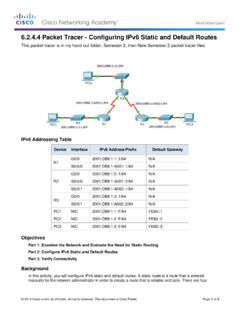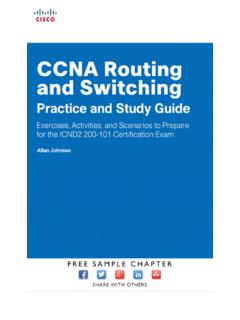Transcription of IT Essentials v5.0 Student Packet Tracer Manual
1 2013 Cisco and/or its affiliates. All rights reserved. This document is Cisco Public. Cisco Networking Academy Program IT Essentials Student Packet Tracer Manual 2014 Cisco and/or its affiliates. All rights reserved. This document is Cisco Public. Page 1 of 3 IT Essentials Adding Computers to an Existing Network Objectives Configure the computers to use DHCP. Configure Static addressing. Use ipconfig to retrieve host IP information. Use ping to verify connectivity. Hint: To ensure that the instructions always remain visible during an activity, click the "Top" check box in the lower left-hand corner of this instruction window.
2 Background In this activity, you will configure two computers in the Branch Office network. The company uses DHCP for dynamic addressing of all PCs. Step 1: Study the Topology The topology shows two PCs, a switch, a server, a router, and a cloud. Considering the PCs: a. Notice the PCs are connected to BranchSwitch using straight-through cables. Packet Tracer uses solid lines to represent Ethernet straight-through links. b. Notice the green dots on each side of the straight-through links (next to each PC and next to BranchSwitch). Green dots on both sides of a link indicate the correct cable type was used to inter-connect those devices. Note: There should be green dots at both ends of each cable connection.
3 If you don t see the green dots navigate to Options > Preferences from Packet Tracer menu and check the Show Link Lights check box. Step 2: Configure DHCP on the PCs a. Click PC0. A PC0 window will appear. b. From the PC0 window, select the Desktop tab. c. Click IP Configuration and select the DHCP button to enable the PC to act as a DHCP client. A DHCP client will receive IP address configuration information dynamically from a DHCP server. (You should see the following message after clicking the DHCP button: DHCP request successful.) d. Close the PC0 configuration window by selecting the x in the upper right-hand corner. e. Click PC1. A PC1 window will appear.
4 F. From the PC1 window, select the Desktop tab. g. Click IP Configuration and select the DHCP button to enable the PC to act as a DHCP client. h. Close the PC1 configuration window. IT Essentials Chapter 6 Packet Tracer /Instructor 2014 Cisco and/or its affiliates. All rights reserved. This document is Cisco Public. Page 2 of 3 Step 3: Observe the IP Configuration Information Assigned to Each PC a. Click PC0. b. Select the Desktop tab. c. Click Command Prompt. d. At the PC> prompt, enter the ipconfig /all command. e. Record the IP address, subnet mask, default gateway, and DNS server address information that was dynamically assigned via DHCP to PC0.
5 F. Record the IP address, subnet mask, default gateway, and DNS server address information that was dynamically assigned via DHCP to PC1. g. Using the ping command, test layer 3 connectivity between the PCs and their default router. At the PC0> prompt, enter ping <PC1 s IP address> At the PC0> prompt, enter ping <router s IP address> At the PC1> prompt, enter ping <PC0 s IP address> At the PC1> prompt, enter ping (BranchOffice FastEthernet 0/0 interface IP address) Step 4: Questions As seen in the topology, straight-through cables were originally used to connect PC0 and PC1 to BranchSwitch. If a cross-over cable had been used to connect PC1 to BranchSwitch, answer the following questions: a.
6 In that scenario, would PC1 have acquired an IP address over DHCP? b. Why? c. What about PC0? Would it have acquired an IP address via DHCP if PC1 was connected to BranchSwitch through a cross-over cable? Step 5: Switching to Static Addressing Despite all the benefits of dynamic addressing schemes such as DHCP, sometimes a static scheme is required. Change PC1 from DHCP to static addressing. a. Click PC1 to bring up its configuration window. b. Click the Desktop tab. c. Click IP Configuration. d. Select Static. e. Enter the IP information as follows: IP Address: IT Essentials Chapter 6 Packet Tracer /Instructor 2014 Cisco and/or its affiliates.
7 All rights reserved. This document is Cisco Public. Page 3 of 3 Subnet Mask: Default Gateway: DNS: f. PC1 is now configured with a static address. g. Close IP Configuration. Step 6: Verifying Connectivity Test connectivity by sending pings across the network. a. Click PC1 to open its configuration window. b. Click Desktop. c. Click Command Prompt. d. Ping the default gateway by typing ping The pings should be successful. e. Ping Server0 by typing ping The pings should be successful. f. Ping router used as the entry point for Corporate cloud by typing ping The pings should be successful. g. Ping a server located inside the Corporate cloud by typing ping The pings should be successful.
8 H. Full connectivity has been achieved within the network. Check your score. It should be 100%. I6 OHlo Nd STc Mtso S 2013 Cisco andT Objective Deve Creat ObseHint: To ensuower left-hanNote: This acdevices. Step 1: CreThe bottom lecategories orMove your cuhe rows of dselected, the option that is a. Selecb. Drag c. Selecd. Chooe. Click f. Click g. The rTraceh. Movei. Chooj. Click k. Click both eStep 2: Cona. Click b. Fromd/or its affiliates. als Cablings lop an underte a simple nerve the impoure that the innd corner of tctivity beginseate a netweft-hand cornr groups, sucursor over theevices. To seoptions withrequired. ct End Devicand drop twoct Connectioose a Copperthe first hostthe second hred dots indicer.
9 This will ae the cursor toose a Copperthe first hostthe second hends of the cnfigure hoPC0. A PC0 the PC0 winAll rights reserveg a Simrstanding of tetwork usingortance of usinstructions althis instructios with a blankwork diagraner of the Pach as Routerse device cateelect a devicin that categces from the o generic PCons from the r Straight-Tht, PC0, and ahost, PC1, ancate an incorallow you to do the cable ar Cross-Ovet, PC0, and ahost, PC1, ancable indicatest names a0 window will ndow, select ed. This documemple Nethe basic fung two the correlways remainon with twcket Tracer ss, Switches, oegories to she, first selectory appear inoptions in theCs (PC-PT) obottom left-hhrough cableassign the cand assign therect cable typdelete the Coand click the er cable typeassign the cand assign thee the correct and IP addappear.
10 The Config tent is Cisco Publietwork ctions of Pacct cable typen visible durin The workspwo PCs screen displaor End Devicow the namet the device cn the box nexe bottom leftonto the Logihand type. able to the Fae cable to thepe. Click the opper Straigcable to dele. able to the Fae cable to thecable onab. to connect ng an activitypace is whereays nine iconces. e of the categcategory. Onxt to the catet-hand cornerical WorkspastEthernete FastEthernred X on theht-Throughete it. astEthernete FastEthernn the PCs PCs. y, click the "Te you place ans that represgory in the bonce the devicegory listingsr. ace. connector. net connectoe right-hand scable.









